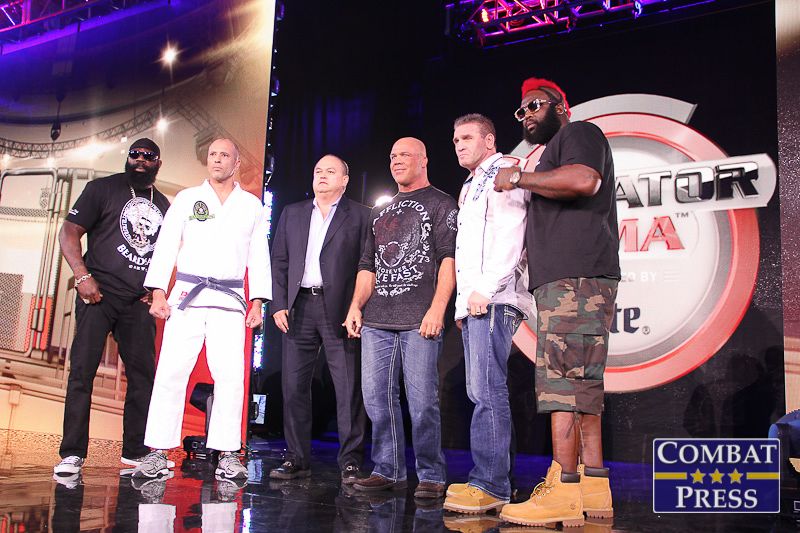The sport of MMA was built on the spectacle. Whether it be Bob Sapp fights, Hong Man Choi against Fedor Emelianenko or Randy Couture dominating James Toney on the ground, there have been way too many instances of fights being made purely for the fun “freak show” factor.
Bellator met both backlash and happiness for its upcoming tentpole event, Bellator 149, which takes place in February. For the event, the promotion is bringing back Kevin “Kimbo Slice” Ferguson, the biggest MMA spectacle it could possibly pull, and two aged legends of the sport in Royce Gracie and Ken Shamrock. Slice will be fighting Dhafir “Dada 5000” Harris, a fellow street-fighting legend with a 2-0 record in MMA. With these two fights, Bellator is going all-in on the high-notoriety names despite their ages and overall skill sets. In doing so, the promotion is possibly pushing other, more important fights down the card. Has Bellator gone too far?
The simple answer is no. The organization hasn’t gone too far. It’s easy to look at these fights and call them for what they are, “sideshow fights” that have the sole purpose of pulling in viewers. What people tend to forget is that Bellator is a business in direct competition with the UFC, a company so big that the sport literally gets called “UFC” by newer fans or people who catch the sport in passing. The UFC is the NFL of MMA. There is no bigger entity. The best men and women fight for the UFC. There is no way around it. And if the UFC is the NFL, then Bellator is the USFL.
These “sideshow fights” are needed to help Bellator directly compete in terms of viewership. In order to make Bellator more successful, these kinds of fights need to happen. Newer fans may tune in just to watch Slice fight, but they might start to follow the sport if the fight is able to capture their attention. Who knows, maybe the combination of Gracie and Shamrock gets older fans that watched the originals and didn’t follow through after the early UFCs to tune in and fall back in love the sport.
The fact remains that Bellator is the No. 2 promotion, but these fights are trying to pull in the casual viewer, not catering to the fans already into the sport who will watch regardless. Bellator head Scott Coker and company are putting on the guilty pleasure fights for us, the fans who are really into the sport. At the same time, they are also catering to a new demographic who will happen to watch because they know of Slice and his street fights or Gracie and his dominance in the early UFC era.
It’s easy to point out that Gracie and Shamrock combined are over 100 years old, or that Gracie hasn’t fought in a year. It’s easy to point to the fact that the fight between Slice and Dada 5000 has no relevant impact on any division in Bellator. But this isn’t for the purposes of relevant divisional fights that will procure a title contender. Instead, these are business decisions to help grow a company that is trying to get out from underneath the UFC’s shadow. Coker has to think outside the box and find an angle that differentiates Bellator from the UFC product. With these legends and spectacles, Bellator is finding its groove.
We all may be asking ourselves about the intentions of these fights or wondering if Bellator has finally gone crazy, but instead we should ask the ultimate question of them all: “Why does Dada 5000 have a sledgehammer in the promotional poster?” That is probably the hardest question to answer of them all.

